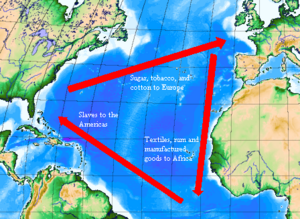Triangular trade facts for kids
The triangular trade was a way of trading goods between three different places. Imagine a big triangle on a map, with ships sailing along its sides. This kind of trade happened when one region had things to sell that weren't needed by the place they usually bought from. So, they would sell their goods to a third region instead. In the past, when ships used sails, these trade routes were also shaped by the wind and ocean currents.
Contents
What Was Triangular Trade?
Triangular trade is simply a system of trading goods that connects three different ports or regions. It's like a three-way exchange. This system often developed when a country needed to sell its products to a place that didn't buy much from them directly. Instead, they would sell to a third place, which then traded with the second.
This type of trade was very common when ships relied on wind and ocean currents. Sailors planned their journeys carefully to use these natural forces. This made the long trips across oceans faster and easier.
The Atlantic Triangular Trade
The most famous example of triangular trade happened across the Atlantic Ocean. This system lasted for a long time, from the late 1500s to the early 1800s. During this period, powerful European countries like Great Britain, Spain, and France had many colonies in the Americas and Africa.
This Atlantic trade involved three main parts:
- Europe (like Britain, Spain, France)
- West Africa
- The Caribbean and American colonies
Ships sailed in a triangle, carrying different goods on each leg of the journey.
The Three Legs of the Journey
The Atlantic triangular trade had three main parts, often called "legs":
Leg 1: Europe to Africa
Ships would leave Europe carrying manufactured goods. These goods included things like cloth, guns, iron tools, and alcohol. They sailed south to the coast of West Africa. In Africa, these goods were traded for enslaved people.
Leg 2: Africa to the Americas (The Middle Passage)
This was the most difficult and tragic part of the journey. The enslaved people were forced onto ships and transported across the Atlantic Ocean to the Americas. This journey was known as the "Middle Passage." Conditions on these ships were terrible, and many people did not survive.
Once in the Americas (especially the Caribbean and southern parts of North America), the enslaved people were sold. They were then forced to work on large farms called plantations.
Leg 3: Americas to Europe
The enslaved people worked to grow valuable crops like sugar, tobacco, and cotton. These "cash crops" were in high demand in Europe. Ships would load up with these crops and sail back across the Atlantic to Europe.
In Europe, these goods were sold for a lot of money. This money was then used to buy more manufactured goods, starting the whole triangular journey again.
Why Was This Trade Important?
The Atlantic triangular trade was a huge part of the global economy for centuries. It was closely linked to an idea called mercantilism. Mercantilism was a belief that a country became powerful by having many colonies and trading only with them. This way, the home country could get raw materials cheaply and sell its manufactured goods.
The trade helped European countries become very rich and powerful. However, it caused immense suffering for millions of enslaved Africans. Their forced labor was essential for growing the valuable crops that fueled this trade.
Goods Traded
Many different goods were part of this system:
- From Europe: Manufactured goods, cloth, guns, alcohol.
- From Africa: Enslaved people.
- From the Americas: Sugar, tobacco, cotton, rum, gold, spices, fish, lumber.
The End of Triangular Trade
Triangular trading systems became less common in the 20th century. This was mainly due to the rise of free trade. Free trade means countries can trade with anyone they want, without strict rules from their home country. Also, ships became more specialized. They could carry specific types of cargo directly between two places, making the three-way route less necessary.
See also
 In Spanish: Comercio triangular para niños
In Spanish: Comercio triangular para niños


